HRM Law and Employee Termination: Challenges and Considerations
VerifiedAdded on 2023/02/01
|12
|3174
|63
Essay
AI Summary
This essay delves into the complexities of human resource management law, specifically focusing on the challenges associated with terminating employees who are ill or have disabilities. The paper highlights the ethical considerations, legal frameworks, and potential impacts on both the organization and the affected employees. It examines the role of statutory job protections and the Fair Work Act in Australia, emphasizing the importance of fairness and non-discrimination. The essay further discusses the negative effects of such terminations, including increased unemployment and decreased morale, and offers recommendations for fostering inclusive and supportive workplaces. The author stresses the importance of recognizing the capabilities of individuals with disabilities and prioritizing their contributions to the organization. This assignment, contributed to Desklib, provides a comprehensive analysis of the topic, offering valuable insights for students and professionals in the field of human resource management.
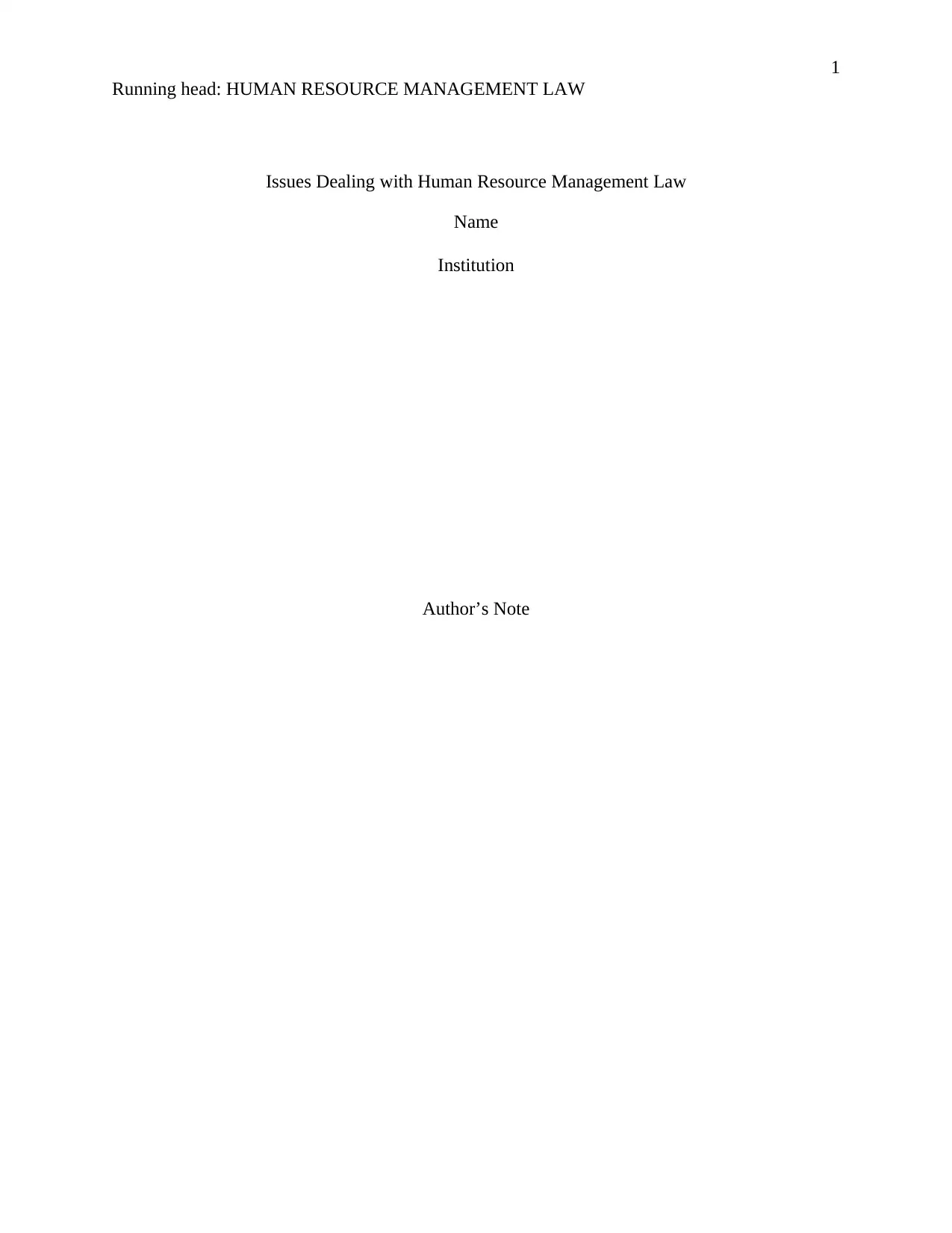
1
Running head: HUMAN RESOURCE MANAGEMENT LAW
Issues Dealing with Human Resource Management Law
Name
Institution
Author’s Note
Running head: HUMAN RESOURCE MANAGEMENT LAW
Issues Dealing with Human Resource Management Law
Name
Institution
Author’s Note
Paraphrase This Document
Need a fresh take? Get an instant paraphrase of this document with our AI Paraphraser
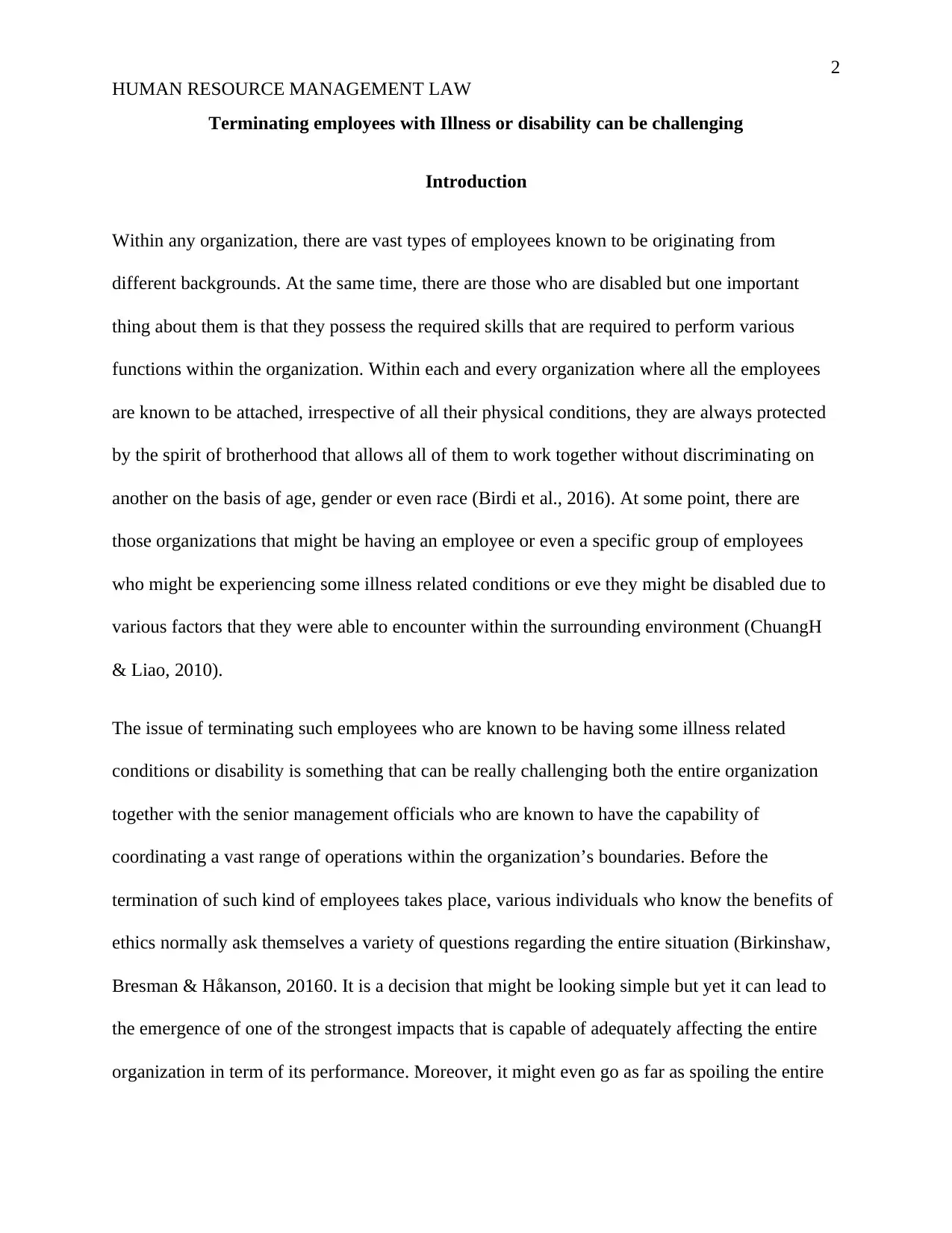
2
HUMAN RESOURCE MANAGEMENT LAW
Terminating employees with Illness or disability can be challenging
Introduction
Within any organization, there are vast types of employees known to be originating from
different backgrounds. At the same time, there are those who are disabled but one important
thing about them is that they possess the required skills that are required to perform various
functions within the organization. Within each and every organization where all the employees
are known to be attached, irrespective of all their physical conditions, they are always protected
by the spirit of brotherhood that allows all of them to work together without discriminating on
another on the basis of age, gender or even race (Birdi et al., 2016). At some point, there are
those organizations that might be having an employee or even a specific group of employees
who might be experiencing some illness related conditions or eve they might be disabled due to
various factors that they were able to encounter within the surrounding environment (ChuangH
& Liao, 2010).
The issue of terminating such employees who are known to be having some illness related
conditions or disability is something that can be really challenging both the entire organization
together with the senior management officials who are known to have the capability of
coordinating a vast range of operations within the organization’s boundaries. Before the
termination of such kind of employees takes place, various individuals who know the benefits of
ethics normally ask themselves a variety of questions regarding the entire situation (Birkinshaw,
Bresman & Håkanson, 20160. It is a decision that might be looking simple but yet it can lead to
the emergence of one of the strongest impacts that is capable of adequately affecting the entire
organization in term of its performance. Moreover, it might even go as far as spoiling the entire
HUMAN RESOURCE MANAGEMENT LAW
Terminating employees with Illness or disability can be challenging
Introduction
Within any organization, there are vast types of employees known to be originating from
different backgrounds. At the same time, there are those who are disabled but one important
thing about them is that they possess the required skills that are required to perform various
functions within the organization. Within each and every organization where all the employees
are known to be attached, irrespective of all their physical conditions, they are always protected
by the spirit of brotherhood that allows all of them to work together without discriminating on
another on the basis of age, gender or even race (Birdi et al., 2016). At some point, there are
those organizations that might be having an employee or even a specific group of employees
who might be experiencing some illness related conditions or eve they might be disabled due to
various factors that they were able to encounter within the surrounding environment (ChuangH
& Liao, 2010).
The issue of terminating such employees who are known to be having some illness related
conditions or disability is something that can be really challenging both the entire organization
together with the senior management officials who are known to have the capability of
coordinating a vast range of operations within the organization’s boundaries. Before the
termination of such kind of employees takes place, various individuals who know the benefits of
ethics normally ask themselves a variety of questions regarding the entire situation (Birkinshaw,
Bresman & Håkanson, 20160. It is a decision that might be looking simple but yet it can lead to
the emergence of one of the strongest impacts that is capable of adequately affecting the entire
organization in term of its performance. Moreover, it might even go as far as spoiling the entire
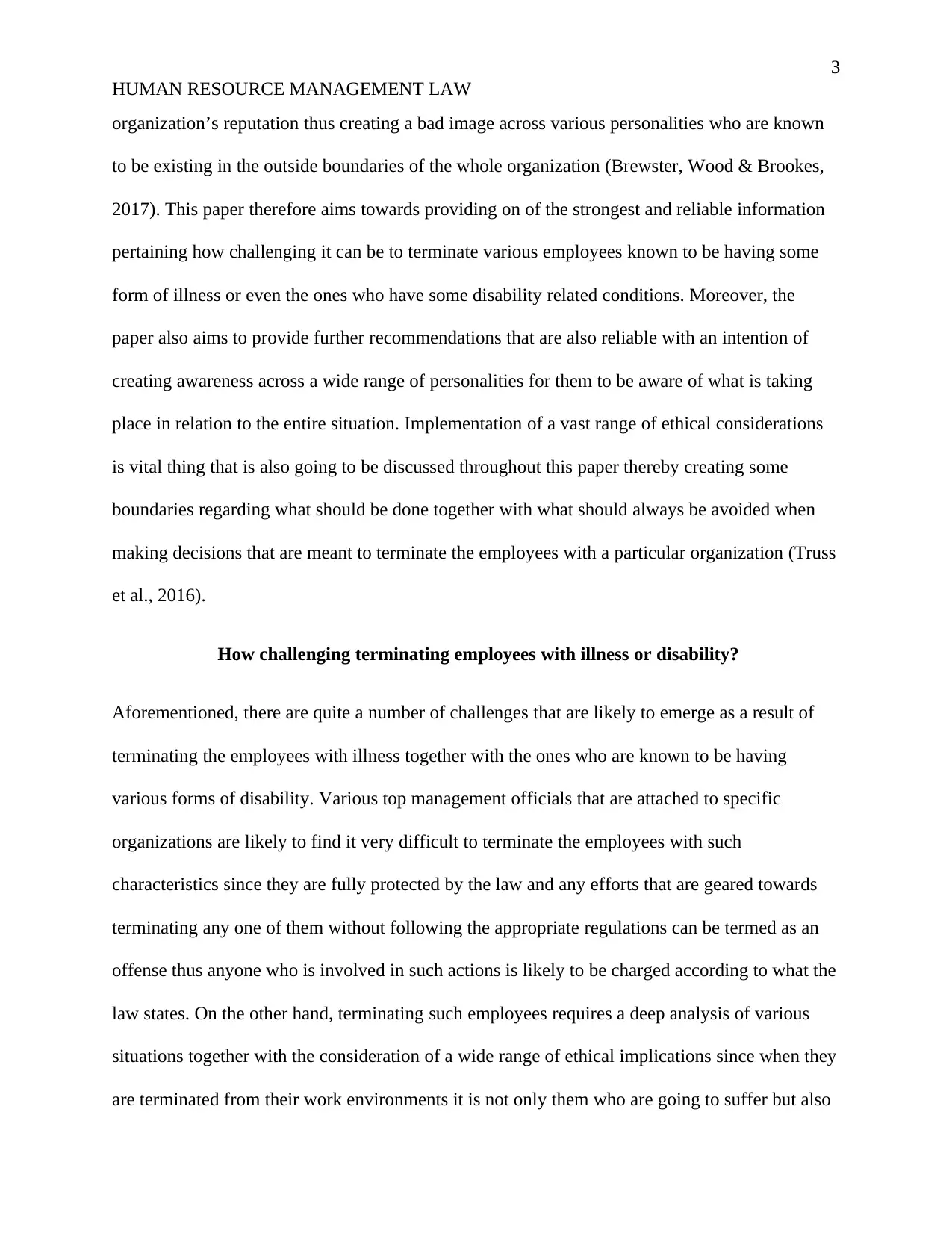
3
HUMAN RESOURCE MANAGEMENT LAW
organization’s reputation thus creating a bad image across various personalities who are known
to be existing in the outside boundaries of the whole organization (Brewster, Wood & Brookes,
2017). This paper therefore aims towards providing on of the strongest and reliable information
pertaining how challenging it can be to terminate various employees known to be having some
form of illness or even the ones who have some disability related conditions. Moreover, the
paper also aims to provide further recommendations that are also reliable with an intention of
creating awareness across a wide range of personalities for them to be aware of what is taking
place in relation to the entire situation. Implementation of a vast range of ethical considerations
is vital thing that is also going to be discussed throughout this paper thereby creating some
boundaries regarding what should be done together with what should always be avoided when
making decisions that are meant to terminate the employees with a particular organization (Truss
et al., 2016).
How challenging terminating employees with illness or disability?
Aforementioned, there are quite a number of challenges that are likely to emerge as a result of
terminating the employees with illness together with the ones who are known to be having
various forms of disability. Various top management officials that are attached to specific
organizations are likely to find it very difficult to terminate the employees with such
characteristics since they are fully protected by the law and any efforts that are geared towards
terminating any one of them without following the appropriate regulations can be termed as an
offense thus anyone who is involved in such actions is likely to be charged according to what the
law states. On the other hand, terminating such employees requires a deep analysis of various
situations together with the consideration of a wide range of ethical implications since when they
are terminated from their work environments it is not only them who are going to suffer but also
HUMAN RESOURCE MANAGEMENT LAW
organization’s reputation thus creating a bad image across various personalities who are known
to be existing in the outside boundaries of the whole organization (Brewster, Wood & Brookes,
2017). This paper therefore aims towards providing on of the strongest and reliable information
pertaining how challenging it can be to terminate various employees known to be having some
form of illness or even the ones who have some disability related conditions. Moreover, the
paper also aims to provide further recommendations that are also reliable with an intention of
creating awareness across a wide range of personalities for them to be aware of what is taking
place in relation to the entire situation. Implementation of a vast range of ethical considerations
is vital thing that is also going to be discussed throughout this paper thereby creating some
boundaries regarding what should be done together with what should always be avoided when
making decisions that are meant to terminate the employees with a particular organization (Truss
et al., 2016).
How challenging terminating employees with illness or disability?
Aforementioned, there are quite a number of challenges that are likely to emerge as a result of
terminating the employees with illness together with the ones who are known to be having
various forms of disability. Various top management officials that are attached to specific
organizations are likely to find it very difficult to terminate the employees with such
characteristics since they are fully protected by the law and any efforts that are geared towards
terminating any one of them without following the appropriate regulations can be termed as an
offense thus anyone who is involved in such actions is likely to be charged according to what the
law states. On the other hand, terminating such employees requires a deep analysis of various
situations together with the consideration of a wide range of ethical implications since when they
are terminated from their work environments it is not only them who are going to suffer but also
⊘ This is a preview!⊘
Do you want full access?
Subscribe today to unlock all pages.

Trusted by 1+ million students worldwide
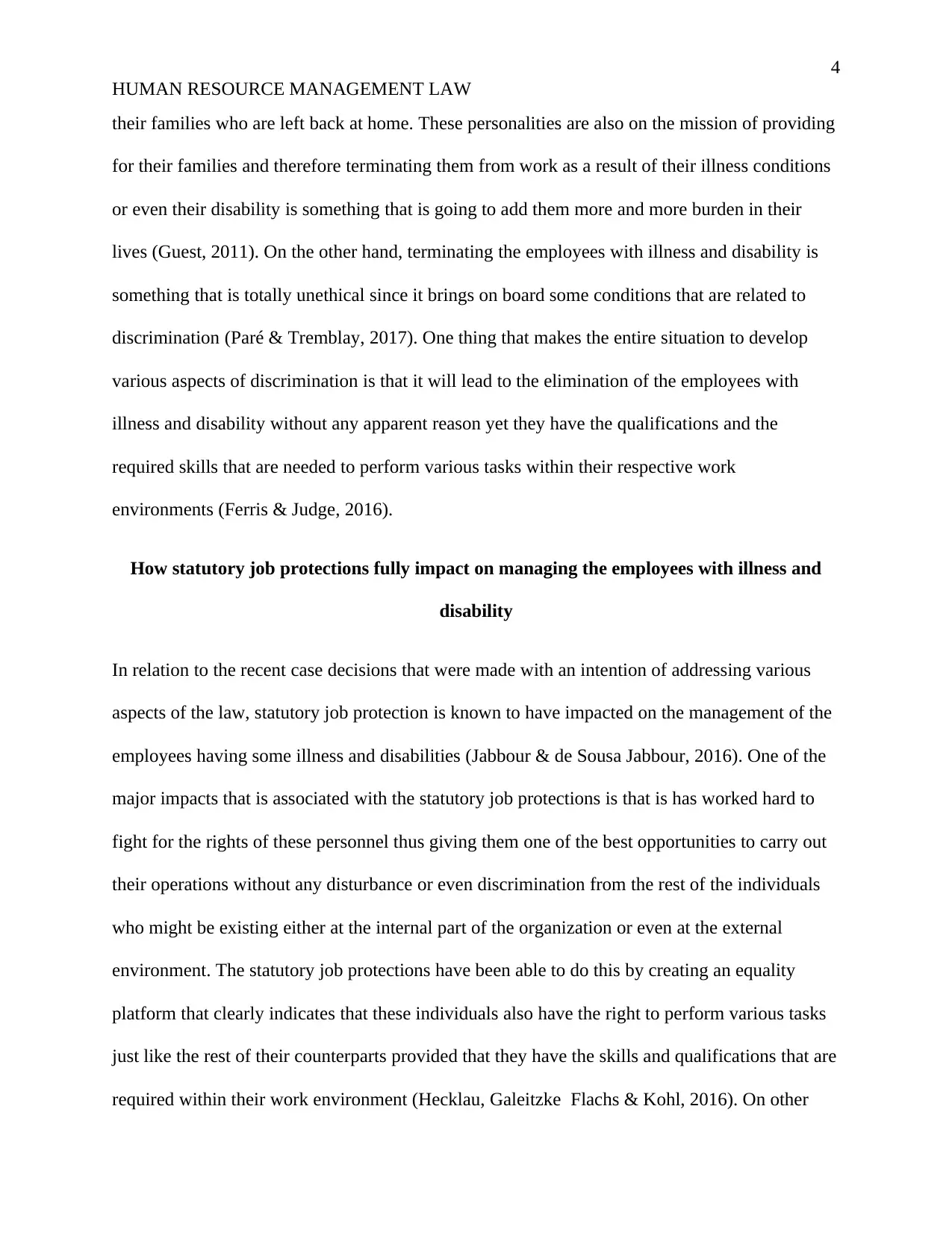
4
HUMAN RESOURCE MANAGEMENT LAW
their families who are left back at home. These personalities are also on the mission of providing
for their families and therefore terminating them from work as a result of their illness conditions
or even their disability is something that is going to add them more and more burden in their
lives (Guest, 2011). On the other hand, terminating the employees with illness and disability is
something that is totally unethical since it brings on board some conditions that are related to
discrimination (Paré & Tremblay, 2017). One thing that makes the entire situation to develop
various aspects of discrimination is that it will lead to the elimination of the employees with
illness and disability without any apparent reason yet they have the qualifications and the
required skills that are needed to perform various tasks within their respective work
environments (Ferris & Judge, 2016).
How statutory job protections fully impact on managing the employees with illness and
disability
In relation to the recent case decisions that were made with an intention of addressing various
aspects of the law, statutory job protection is known to have impacted on the management of the
employees having some illness and disabilities (Jabbour & de Sousa Jabbour, 2016). One of the
major impacts that is associated with the statutory job protections is that is has worked hard to
fight for the rights of these personnel thus giving them one of the best opportunities to carry out
their operations without any disturbance or even discrimination from the rest of the individuals
who might be existing either at the internal part of the organization or even at the external
environment. The statutory job protections have been able to do this by creating an equality
platform that clearly indicates that these individuals also have the right to perform various tasks
just like the rest of their counterparts provided that they have the skills and qualifications that are
required within their work environment (Hecklau, Galeitzke Flachs & Kohl, 2016). On other
HUMAN RESOURCE MANAGEMENT LAW
their families who are left back at home. These personalities are also on the mission of providing
for their families and therefore terminating them from work as a result of their illness conditions
or even their disability is something that is going to add them more and more burden in their
lives (Guest, 2011). On the other hand, terminating the employees with illness and disability is
something that is totally unethical since it brings on board some conditions that are related to
discrimination (Paré & Tremblay, 2017). One thing that makes the entire situation to develop
various aspects of discrimination is that it will lead to the elimination of the employees with
illness and disability without any apparent reason yet they have the qualifications and the
required skills that are needed to perform various tasks within their respective work
environments (Ferris & Judge, 2016).
How statutory job protections fully impact on managing the employees with illness and
disability
In relation to the recent case decisions that were made with an intention of addressing various
aspects of the law, statutory job protection is known to have impacted on the management of the
employees having some illness and disabilities (Jabbour & de Sousa Jabbour, 2016). One of the
major impacts that is associated with the statutory job protections is that is has worked hard to
fight for the rights of these personnel thus giving them one of the best opportunities to carry out
their operations without any disturbance or even discrimination from the rest of the individuals
who might be existing either at the internal part of the organization or even at the external
environment. The statutory job protections have been able to do this by creating an equality
platform that clearly indicates that these individuals also have the right to perform various tasks
just like the rest of their counterparts provided that they have the skills and qualifications that are
required within their work environment (Hecklau, Galeitzke Flachs & Kohl, 2016). On other
Paraphrase This Document
Need a fresh take? Get an instant paraphrase of this document with our AI Paraphraser
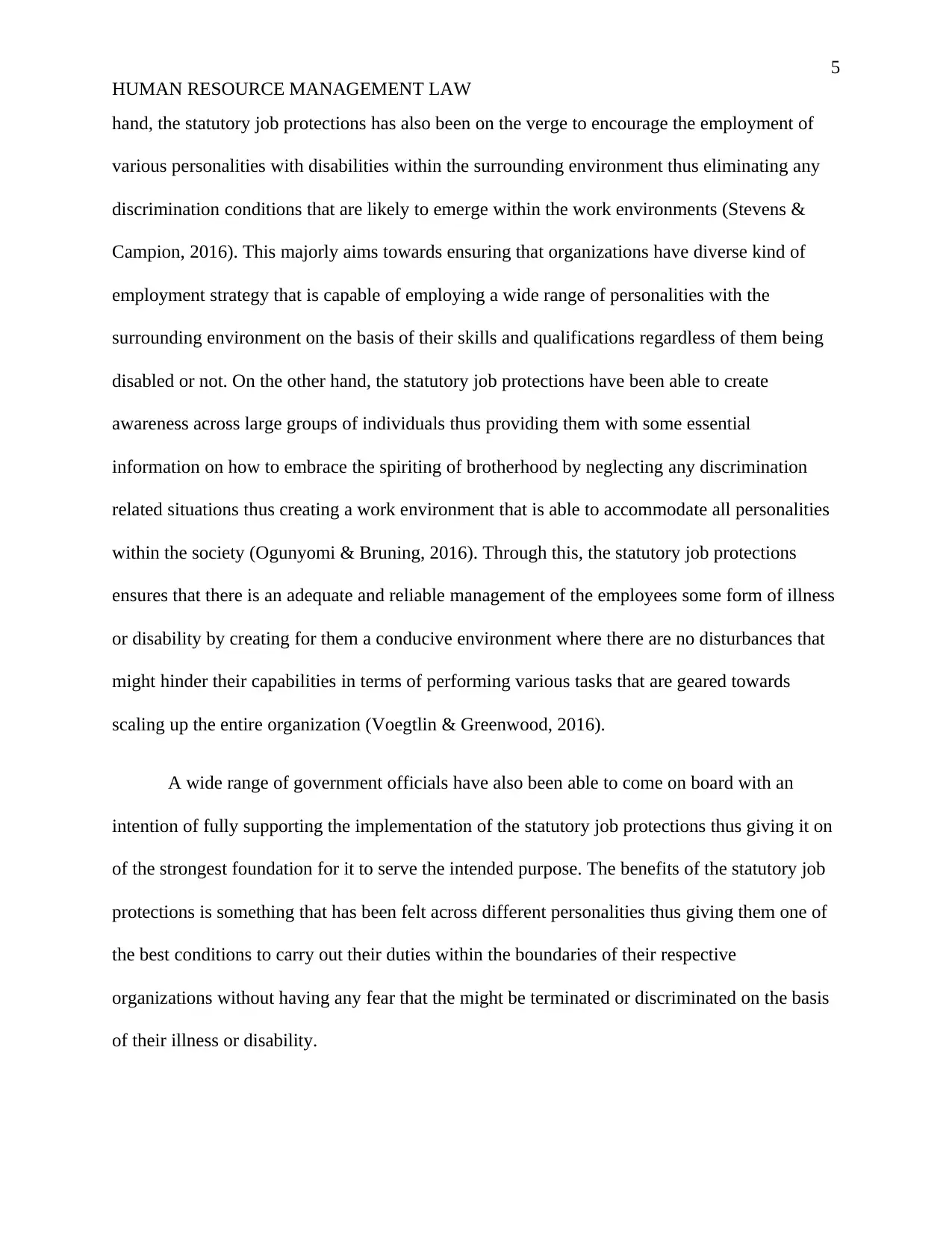
5
HUMAN RESOURCE MANAGEMENT LAW
hand, the statutory job protections has also been on the verge to encourage the employment of
various personalities with disabilities within the surrounding environment thus eliminating any
discrimination conditions that are likely to emerge within the work environments (Stevens &
Campion, 2016). This majorly aims towards ensuring that organizations have diverse kind of
employment strategy that is capable of employing a wide range of personalities with the
surrounding environment on the basis of their skills and qualifications regardless of them being
disabled or not. On the other hand, the statutory job protections have been able to create
awareness across large groups of individuals thus providing them with some essential
information on how to embrace the spiriting of brotherhood by neglecting any discrimination
related situations thus creating a work environment that is able to accommodate all personalities
within the society (Ogunyomi & Bruning, 2016). Through this, the statutory job protections
ensures that there is an adequate and reliable management of the employees some form of illness
or disability by creating for them a conducive environment where there are no disturbances that
might hinder their capabilities in terms of performing various tasks that are geared towards
scaling up the entire organization (Voegtlin & Greenwood, 2016).
A wide range of government officials have also been able to come on board with an
intention of fully supporting the implementation of the statutory job protections thus giving it on
of the strongest foundation for it to serve the intended purpose. The benefits of the statutory job
protections is something that has been felt across different personalities thus giving them one of
the best conditions to carry out their duties within the boundaries of their respective
organizations without having any fear that the might be terminated or discriminated on the basis
of their illness or disability.
HUMAN RESOURCE MANAGEMENT LAW
hand, the statutory job protections has also been on the verge to encourage the employment of
various personalities with disabilities within the surrounding environment thus eliminating any
discrimination conditions that are likely to emerge within the work environments (Stevens &
Campion, 2016). This majorly aims towards ensuring that organizations have diverse kind of
employment strategy that is capable of employing a wide range of personalities with the
surrounding environment on the basis of their skills and qualifications regardless of them being
disabled or not. On the other hand, the statutory job protections have been able to create
awareness across large groups of individuals thus providing them with some essential
information on how to embrace the spiriting of brotherhood by neglecting any discrimination
related situations thus creating a work environment that is able to accommodate all personalities
within the society (Ogunyomi & Bruning, 2016). Through this, the statutory job protections
ensures that there is an adequate and reliable management of the employees some form of illness
or disability by creating for them a conducive environment where there are no disturbances that
might hinder their capabilities in terms of performing various tasks that are geared towards
scaling up the entire organization (Voegtlin & Greenwood, 2016).
A wide range of government officials have also been able to come on board with an
intention of fully supporting the implementation of the statutory job protections thus giving it on
of the strongest foundation for it to serve the intended purpose. The benefits of the statutory job
protections is something that has been felt across different personalities thus giving them one of
the best conditions to carry out their duties within the boundaries of their respective
organizations without having any fear that the might be terminated or discriminated on the basis
of their illness or disability.
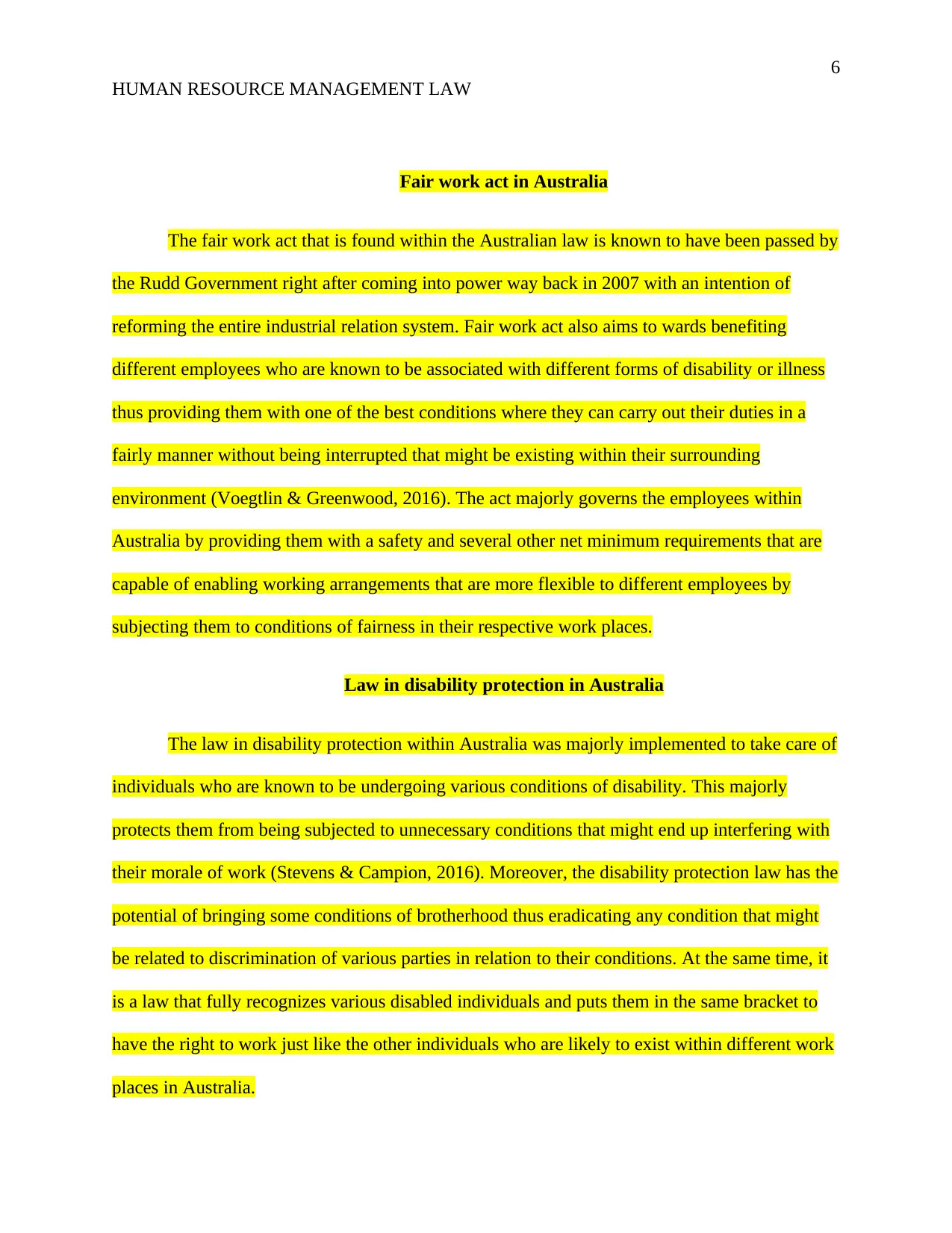
6
HUMAN RESOURCE MANAGEMENT LAW
Fair work act in Australia
The fair work act that is found within the Australian law is known to have been passed by
the Rudd Government right after coming into power way back in 2007 with an intention of
reforming the entire industrial relation system. Fair work act also aims to wards benefiting
different employees who are known to be associated with different forms of disability or illness
thus providing them with one of the best conditions where they can carry out their duties in a
fairly manner without being interrupted that might be existing within their surrounding
environment (Voegtlin & Greenwood, 2016). The act majorly governs the employees within
Australia by providing them with a safety and several other net minimum requirements that are
capable of enabling working arrangements that are more flexible to different employees by
subjecting them to conditions of fairness in their respective work places.
Law in disability protection in Australia
The law in disability protection within Australia was majorly implemented to take care of
individuals who are known to be undergoing various conditions of disability. This majorly
protects them from being subjected to unnecessary conditions that might end up interfering with
their morale of work (Stevens & Campion, 2016). Moreover, the disability protection law has the
potential of bringing some conditions of brotherhood thus eradicating any condition that might
be related to discrimination of various parties in relation to their conditions. At the same time, it
is a law that fully recognizes various disabled individuals and puts them in the same bracket to
have the right to work just like the other individuals who are likely to exist within different work
places in Australia.
HUMAN RESOURCE MANAGEMENT LAW
Fair work act in Australia
The fair work act that is found within the Australian law is known to have been passed by
the Rudd Government right after coming into power way back in 2007 with an intention of
reforming the entire industrial relation system. Fair work act also aims to wards benefiting
different employees who are known to be associated with different forms of disability or illness
thus providing them with one of the best conditions where they can carry out their duties in a
fairly manner without being interrupted that might be existing within their surrounding
environment (Voegtlin & Greenwood, 2016). The act majorly governs the employees within
Australia by providing them with a safety and several other net minimum requirements that are
capable of enabling working arrangements that are more flexible to different employees by
subjecting them to conditions of fairness in their respective work places.
Law in disability protection in Australia
The law in disability protection within Australia was majorly implemented to take care of
individuals who are known to be undergoing various conditions of disability. This majorly
protects them from being subjected to unnecessary conditions that might end up interfering with
their morale of work (Stevens & Campion, 2016). Moreover, the disability protection law has the
potential of bringing some conditions of brotherhood thus eradicating any condition that might
be related to discrimination of various parties in relation to their conditions. At the same time, it
is a law that fully recognizes various disabled individuals and puts them in the same bracket to
have the right to work just like the other individuals who are likely to exist within different work
places in Australia.
⊘ This is a preview!⊘
Do you want full access?
Subscribe today to unlock all pages.

Trusted by 1+ million students worldwide
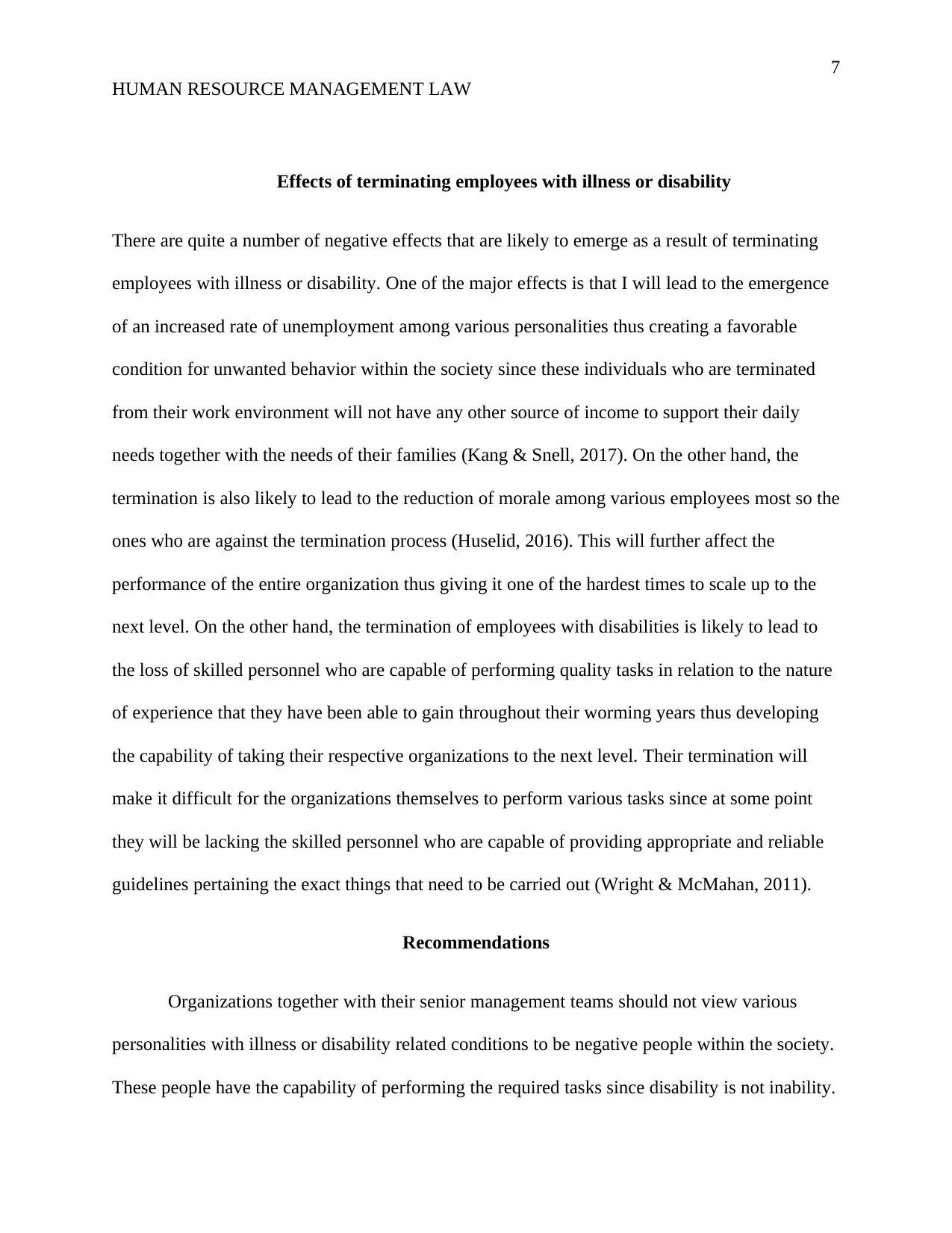
7
HUMAN RESOURCE MANAGEMENT LAW
Effects of terminating employees with illness or disability
There are quite a number of negative effects that are likely to emerge as a result of terminating
employees with illness or disability. One of the major effects is that I will lead to the emergence
of an increased rate of unemployment among various personalities thus creating a favorable
condition for unwanted behavior within the society since these individuals who are terminated
from their work environment will not have any other source of income to support their daily
needs together with the needs of their families (Kang & Snell, 2017). On the other hand, the
termination is also likely to lead to the reduction of morale among various employees most so the
ones who are against the termination process (Huselid, 2016). This will further affect the
performance of the entire organization thus giving it one of the hardest times to scale up to the
next level. On the other hand, the termination of employees with disabilities is likely to lead to
the loss of skilled personnel who are capable of performing quality tasks in relation to the nature
of experience that they have been able to gain throughout their worming years thus developing
the capability of taking their respective organizations to the next level. Their termination will
make it difficult for the organizations themselves to perform various tasks since at some point
they will be lacking the skilled personnel who are capable of providing appropriate and reliable
guidelines pertaining the exact things that need to be carried out (Wright & McMahan, 2011).
Recommendations
Organizations together with their senior management teams should not view various
personalities with illness or disability related conditions to be negative people within the society.
These people have the capability of performing the required tasks since disability is not inability.
HUMAN RESOURCE MANAGEMENT LAW
Effects of terminating employees with illness or disability
There are quite a number of negative effects that are likely to emerge as a result of terminating
employees with illness or disability. One of the major effects is that I will lead to the emergence
of an increased rate of unemployment among various personalities thus creating a favorable
condition for unwanted behavior within the society since these individuals who are terminated
from their work environment will not have any other source of income to support their daily
needs together with the needs of their families (Kang & Snell, 2017). On the other hand, the
termination is also likely to lead to the reduction of morale among various employees most so the
ones who are against the termination process (Huselid, 2016). This will further affect the
performance of the entire organization thus giving it one of the hardest times to scale up to the
next level. On the other hand, the termination of employees with disabilities is likely to lead to
the loss of skilled personnel who are capable of performing quality tasks in relation to the nature
of experience that they have been able to gain throughout their worming years thus developing
the capability of taking their respective organizations to the next level. Their termination will
make it difficult for the organizations themselves to perform various tasks since at some point
they will be lacking the skilled personnel who are capable of providing appropriate and reliable
guidelines pertaining the exact things that need to be carried out (Wright & McMahan, 2011).
Recommendations
Organizations together with their senior management teams should not view various
personalities with illness or disability related conditions to be negative people within the society.
These people have the capability of performing the required tasks since disability is not inability.
Paraphrase This Document
Need a fresh take? Get an instant paraphrase of this document with our AI Paraphraser
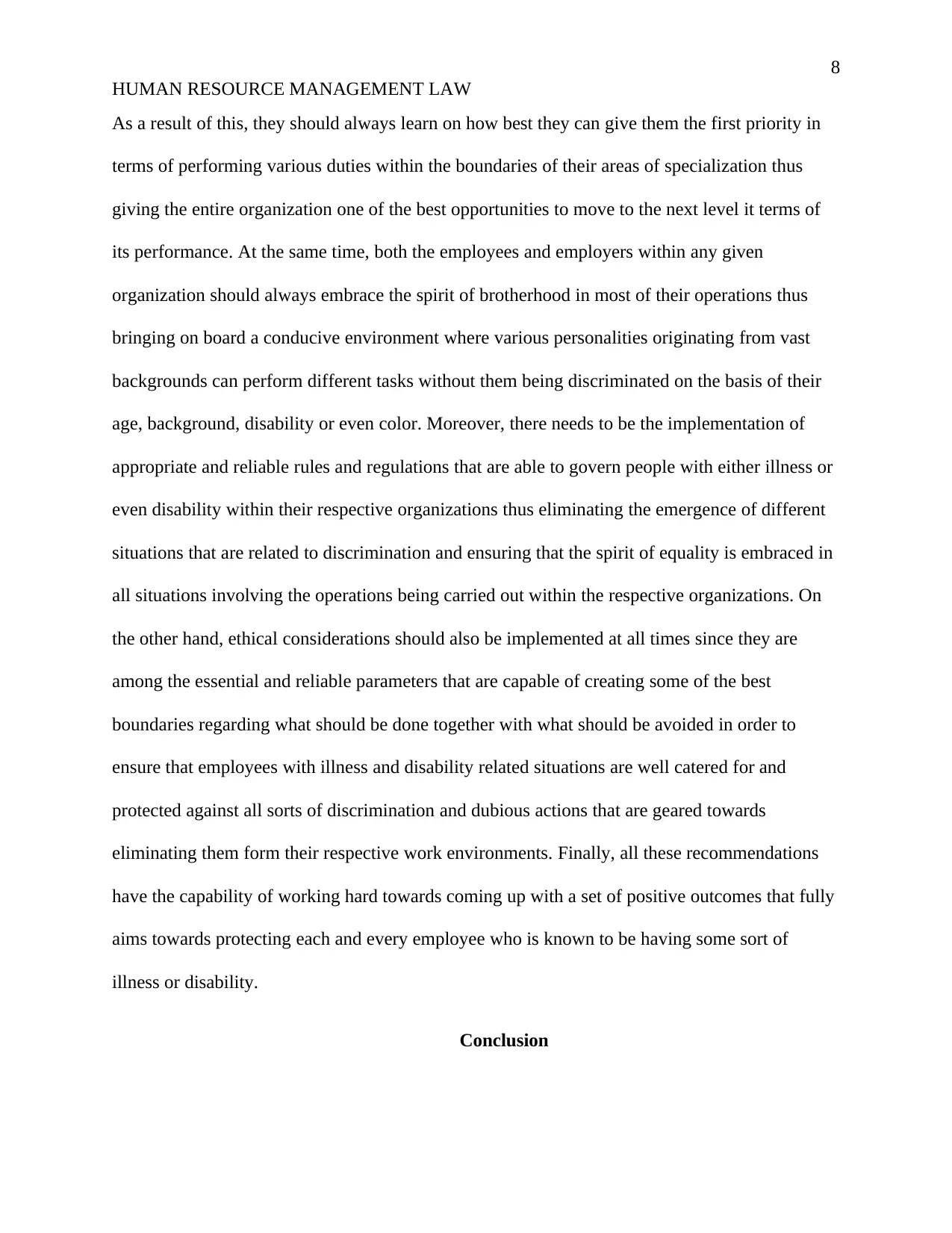
8
HUMAN RESOURCE MANAGEMENT LAW
As a result of this, they should always learn on how best they can give them the first priority in
terms of performing various duties within the boundaries of their areas of specialization thus
giving the entire organization one of the best opportunities to move to the next level it terms of
its performance. At the same time, both the employees and employers within any given
organization should always embrace the spirit of brotherhood in most of their operations thus
bringing on board a conducive environment where various personalities originating from vast
backgrounds can perform different tasks without them being discriminated on the basis of their
age, background, disability or even color. Moreover, there needs to be the implementation of
appropriate and reliable rules and regulations that are able to govern people with either illness or
even disability within their respective organizations thus eliminating the emergence of different
situations that are related to discrimination and ensuring that the spirit of equality is embraced in
all situations involving the operations being carried out within the respective organizations. On
the other hand, ethical considerations should also be implemented at all times since they are
among the essential and reliable parameters that are capable of creating some of the best
boundaries regarding what should be done together with what should be avoided in order to
ensure that employees with illness and disability related situations are well catered for and
protected against all sorts of discrimination and dubious actions that are geared towards
eliminating them form their respective work environments. Finally, all these recommendations
have the capability of working hard towards coming up with a set of positive outcomes that fully
aims towards protecting each and every employee who is known to be having some sort of
illness or disability.
Conclusion
HUMAN RESOURCE MANAGEMENT LAW
As a result of this, they should always learn on how best they can give them the first priority in
terms of performing various duties within the boundaries of their areas of specialization thus
giving the entire organization one of the best opportunities to move to the next level it terms of
its performance. At the same time, both the employees and employers within any given
organization should always embrace the spirit of brotherhood in most of their operations thus
bringing on board a conducive environment where various personalities originating from vast
backgrounds can perform different tasks without them being discriminated on the basis of their
age, background, disability or even color. Moreover, there needs to be the implementation of
appropriate and reliable rules and regulations that are able to govern people with either illness or
even disability within their respective organizations thus eliminating the emergence of different
situations that are related to discrimination and ensuring that the spirit of equality is embraced in
all situations involving the operations being carried out within the respective organizations. On
the other hand, ethical considerations should also be implemented at all times since they are
among the essential and reliable parameters that are capable of creating some of the best
boundaries regarding what should be done together with what should be avoided in order to
ensure that employees with illness and disability related situations are well catered for and
protected against all sorts of discrimination and dubious actions that are geared towards
eliminating them form their respective work environments. Finally, all these recommendations
have the capability of working hard towards coming up with a set of positive outcomes that fully
aims towards protecting each and every employee who is known to be having some sort of
illness or disability.
Conclusion
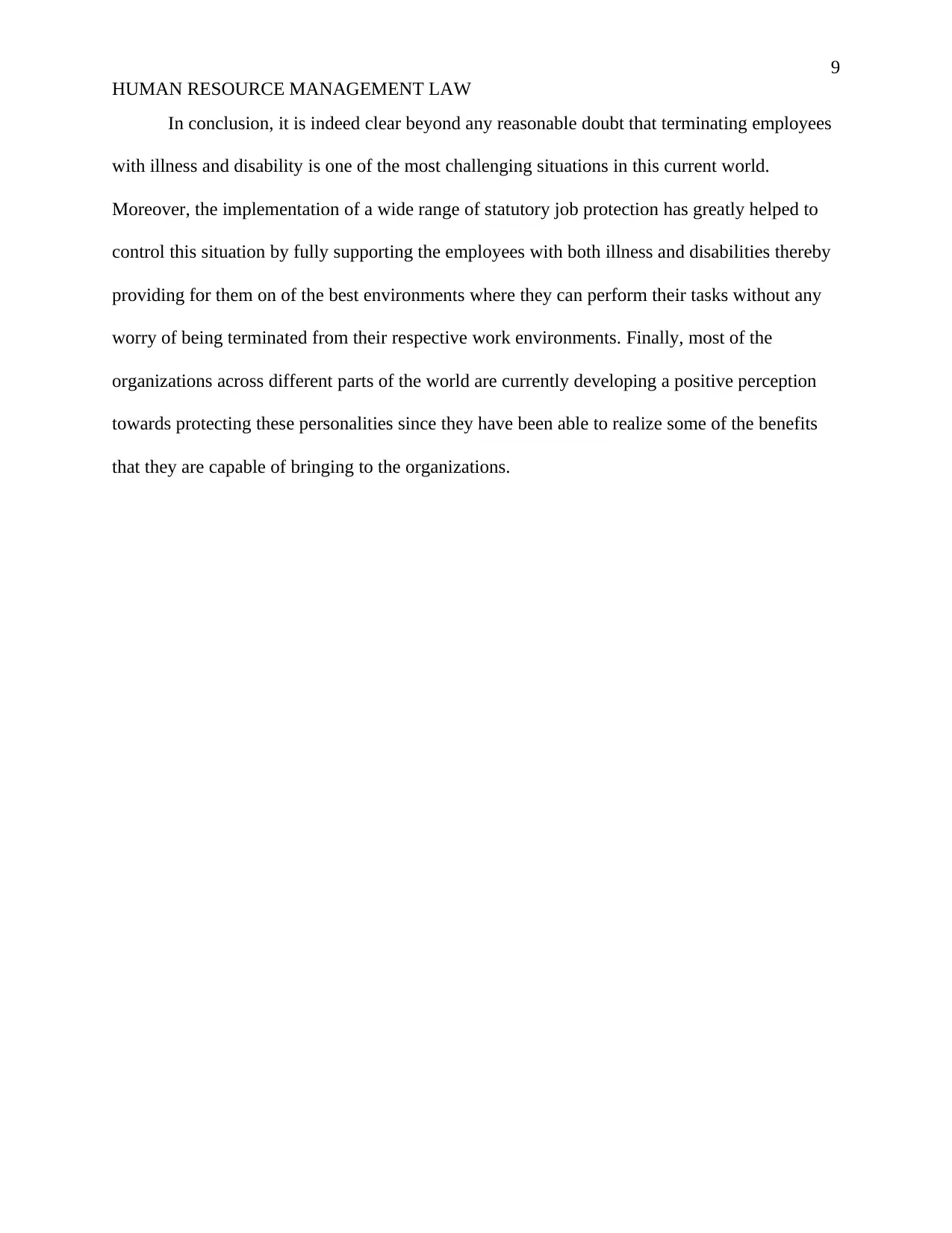
9
HUMAN RESOURCE MANAGEMENT LAW
In conclusion, it is indeed clear beyond any reasonable doubt that terminating employees
with illness and disability is one of the most challenging situations in this current world.
Moreover, the implementation of a wide range of statutory job protection has greatly helped to
control this situation by fully supporting the employees with both illness and disabilities thereby
providing for them on of the best environments where they can perform their tasks without any
worry of being terminated from their respective work environments. Finally, most of the
organizations across different parts of the world are currently developing a positive perception
towards protecting these personalities since they have been able to realize some of the benefits
that they are capable of bringing to the organizations.
HUMAN RESOURCE MANAGEMENT LAW
In conclusion, it is indeed clear beyond any reasonable doubt that terminating employees
with illness and disability is one of the most challenging situations in this current world.
Moreover, the implementation of a wide range of statutory job protection has greatly helped to
control this situation by fully supporting the employees with both illness and disabilities thereby
providing for them on of the best environments where they can perform their tasks without any
worry of being terminated from their respective work environments. Finally, most of the
organizations across different parts of the world are currently developing a positive perception
towards protecting these personalities since they have been able to realize some of the benefits
that they are capable of bringing to the organizations.
⊘ This is a preview!⊘
Do you want full access?
Subscribe today to unlock all pages.

Trusted by 1+ million students worldwide
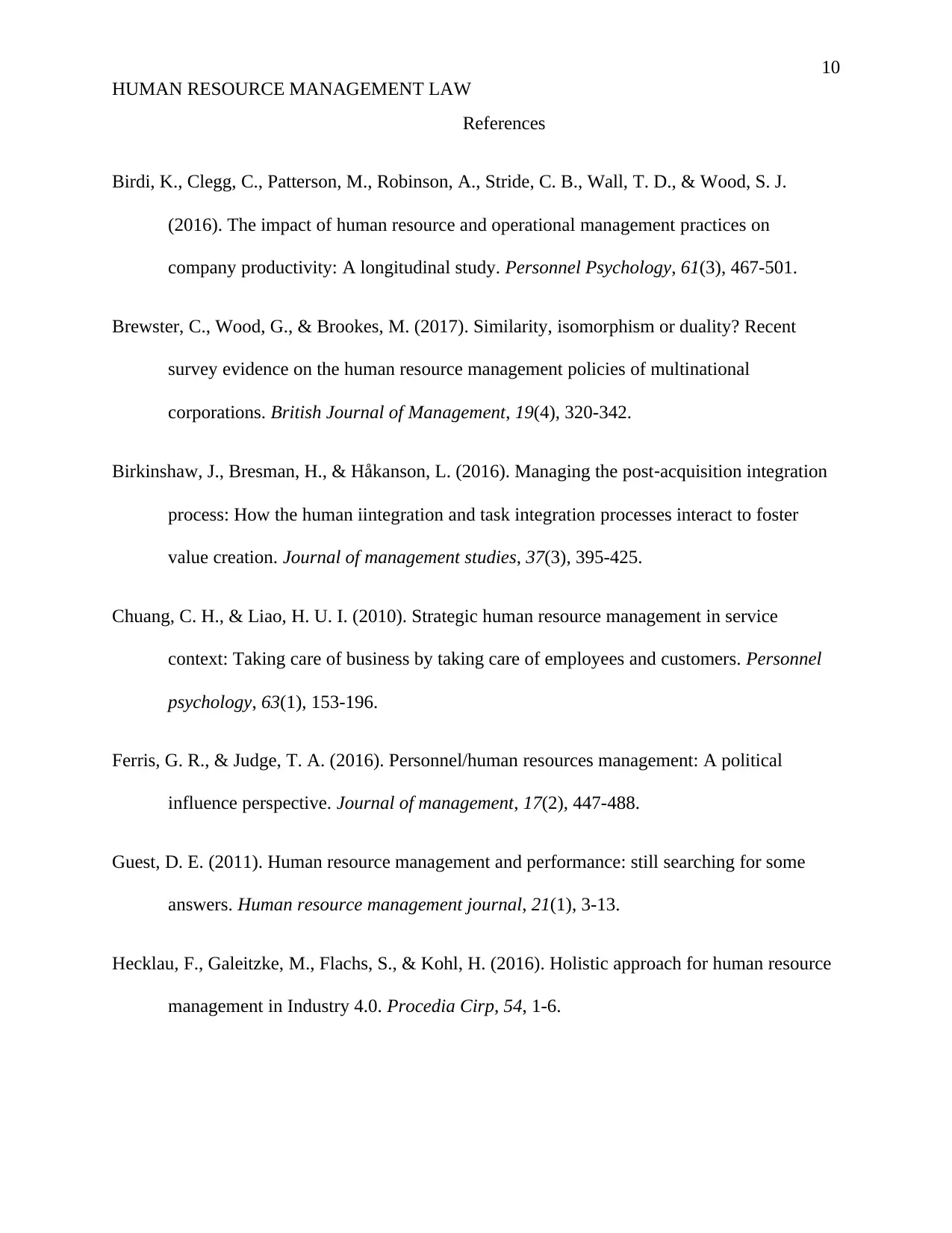
10
HUMAN RESOURCE MANAGEMENT LAW
References
Birdi, K., Clegg, C., Patterson, M., Robinson, A., Stride, C. B., Wall, T. D., & Wood, S. J.
(2016). The impact of human resource and operational management practices on
company productivity: A longitudinal study. Personnel Psychology, 61(3), 467-501.
Brewster, C., Wood, G., & Brookes, M. (2017). Similarity, isomorphism or duality? Recent
survey evidence on the human resource management policies of multinational
corporations. British Journal of Management, 19(4), 320-342.
Birkinshaw, J., Bresman, H., & Håkanson, L. (2016). Managing the post‐acquisition integration
process: How the human iintegration and task integration processes interact to foster
value creation. Journal of management studies, 37(3), 395-425.
Chuang, C. H., & Liao, H. U. I. (2010). Strategic human resource management in service
context: Taking care of business by taking care of employees and customers. Personnel
psychology, 63(1), 153-196.
Ferris, G. R., & Judge, T. A. (2016). Personnel/human resources management: A political
influence perspective. Journal of management, 17(2), 447-488.
Guest, D. E. (2011). Human resource management and performance: still searching for some
answers. Human resource management journal, 21(1), 3-13.
Hecklau, F., Galeitzke, M., Flachs, S., & Kohl, H. (2016). Holistic approach for human resource
management in Industry 4.0. Procedia Cirp, 54, 1-6.
HUMAN RESOURCE MANAGEMENT LAW
References
Birdi, K., Clegg, C., Patterson, M., Robinson, A., Stride, C. B., Wall, T. D., & Wood, S. J.
(2016). The impact of human resource and operational management practices on
company productivity: A longitudinal study. Personnel Psychology, 61(3), 467-501.
Brewster, C., Wood, G., & Brookes, M. (2017). Similarity, isomorphism or duality? Recent
survey evidence on the human resource management policies of multinational
corporations. British Journal of Management, 19(4), 320-342.
Birkinshaw, J., Bresman, H., & Håkanson, L. (2016). Managing the post‐acquisition integration
process: How the human iintegration and task integration processes interact to foster
value creation. Journal of management studies, 37(3), 395-425.
Chuang, C. H., & Liao, H. U. I. (2010). Strategic human resource management in service
context: Taking care of business by taking care of employees and customers. Personnel
psychology, 63(1), 153-196.
Ferris, G. R., & Judge, T. A. (2016). Personnel/human resources management: A political
influence perspective. Journal of management, 17(2), 447-488.
Guest, D. E. (2011). Human resource management and performance: still searching for some
answers. Human resource management journal, 21(1), 3-13.
Hecklau, F., Galeitzke, M., Flachs, S., & Kohl, H. (2016). Holistic approach for human resource
management in Industry 4.0. Procedia Cirp, 54, 1-6.
Paraphrase This Document
Need a fresh take? Get an instant paraphrase of this document with our AI Paraphraser
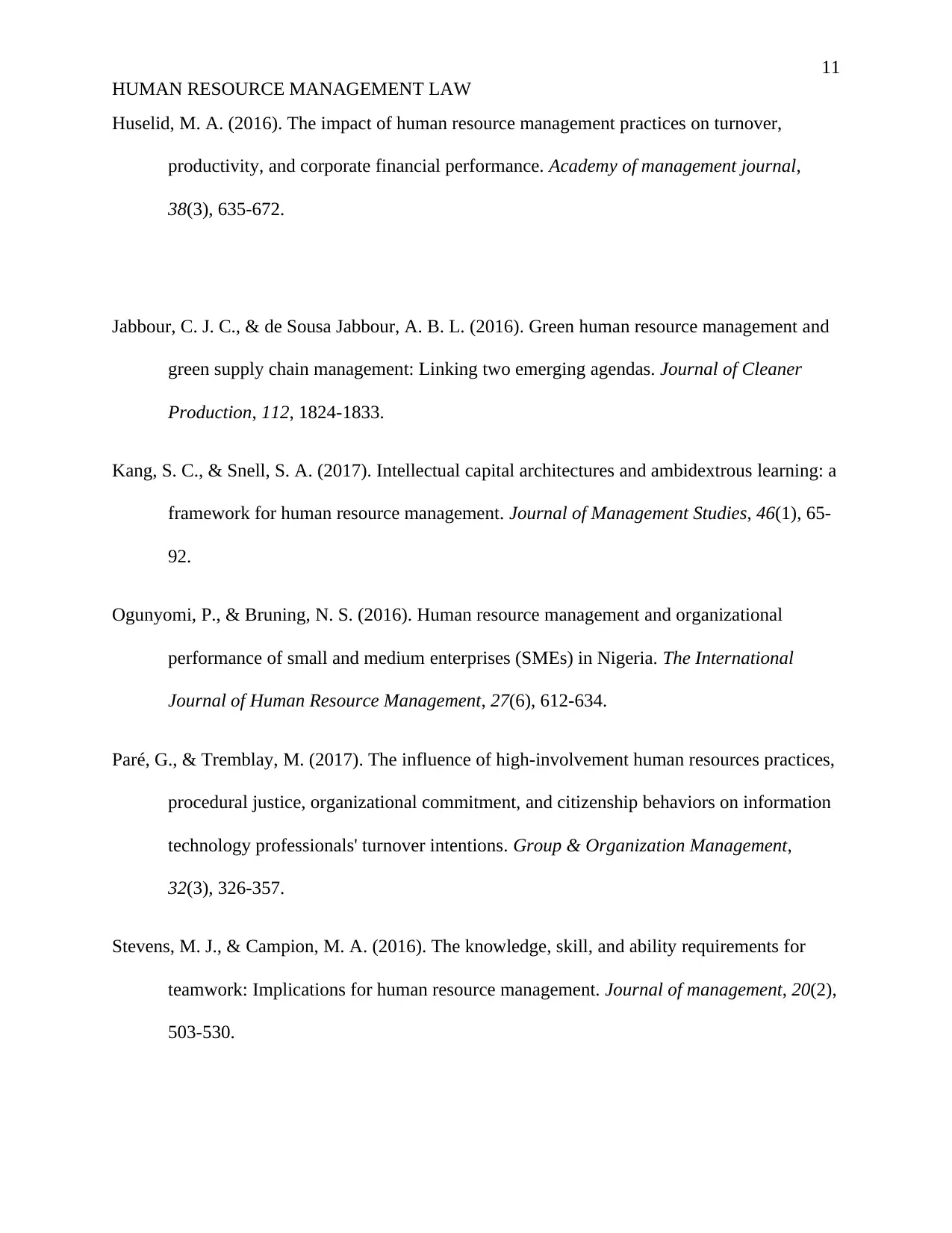
11
HUMAN RESOURCE MANAGEMENT LAW
Huselid, M. A. (2016). The impact of human resource management practices on turnover,
productivity, and corporate financial performance. Academy of management journal,
38(3), 635-672.
Jabbour, C. J. C., & de Sousa Jabbour, A. B. L. (2016). Green human resource management and
green supply chain management: Linking two emerging agendas. Journal of Cleaner
Production, 112, 1824-1833.
Kang, S. C., & Snell, S. A. (2017). Intellectual capital architectures and ambidextrous learning: a
framework for human resource management. Journal of Management Studies, 46(1), 65-
92.
Ogunyomi, P., & Bruning, N. S. (2016). Human resource management and organizational
performance of small and medium enterprises (SMEs) in Nigeria. The International
Journal of Human Resource Management, 27(6), 612-634.
Paré, G., & Tremblay, M. (2017). The influence of high-involvement human resources practices,
procedural justice, organizational commitment, and citizenship behaviors on information
technology professionals' turnover intentions. Group & Organization Management,
32(3), 326-357.
Stevens, M. J., & Campion, M. A. (2016). The knowledge, skill, and ability requirements for
teamwork: Implications for human resource management. Journal of management, 20(2),
503-530.
HUMAN RESOURCE MANAGEMENT LAW
Huselid, M. A. (2016). The impact of human resource management practices on turnover,
productivity, and corporate financial performance. Academy of management journal,
38(3), 635-672.
Jabbour, C. J. C., & de Sousa Jabbour, A. B. L. (2016). Green human resource management and
green supply chain management: Linking two emerging agendas. Journal of Cleaner
Production, 112, 1824-1833.
Kang, S. C., & Snell, S. A. (2017). Intellectual capital architectures and ambidextrous learning: a
framework for human resource management. Journal of Management Studies, 46(1), 65-
92.
Ogunyomi, P., & Bruning, N. S. (2016). Human resource management and organizational
performance of small and medium enterprises (SMEs) in Nigeria. The International
Journal of Human Resource Management, 27(6), 612-634.
Paré, G., & Tremblay, M. (2017). The influence of high-involvement human resources practices,
procedural justice, organizational commitment, and citizenship behaviors on information
technology professionals' turnover intentions. Group & Organization Management,
32(3), 326-357.
Stevens, M. J., & Campion, M. A. (2016). The knowledge, skill, and ability requirements for
teamwork: Implications for human resource management. Journal of management, 20(2),
503-530.
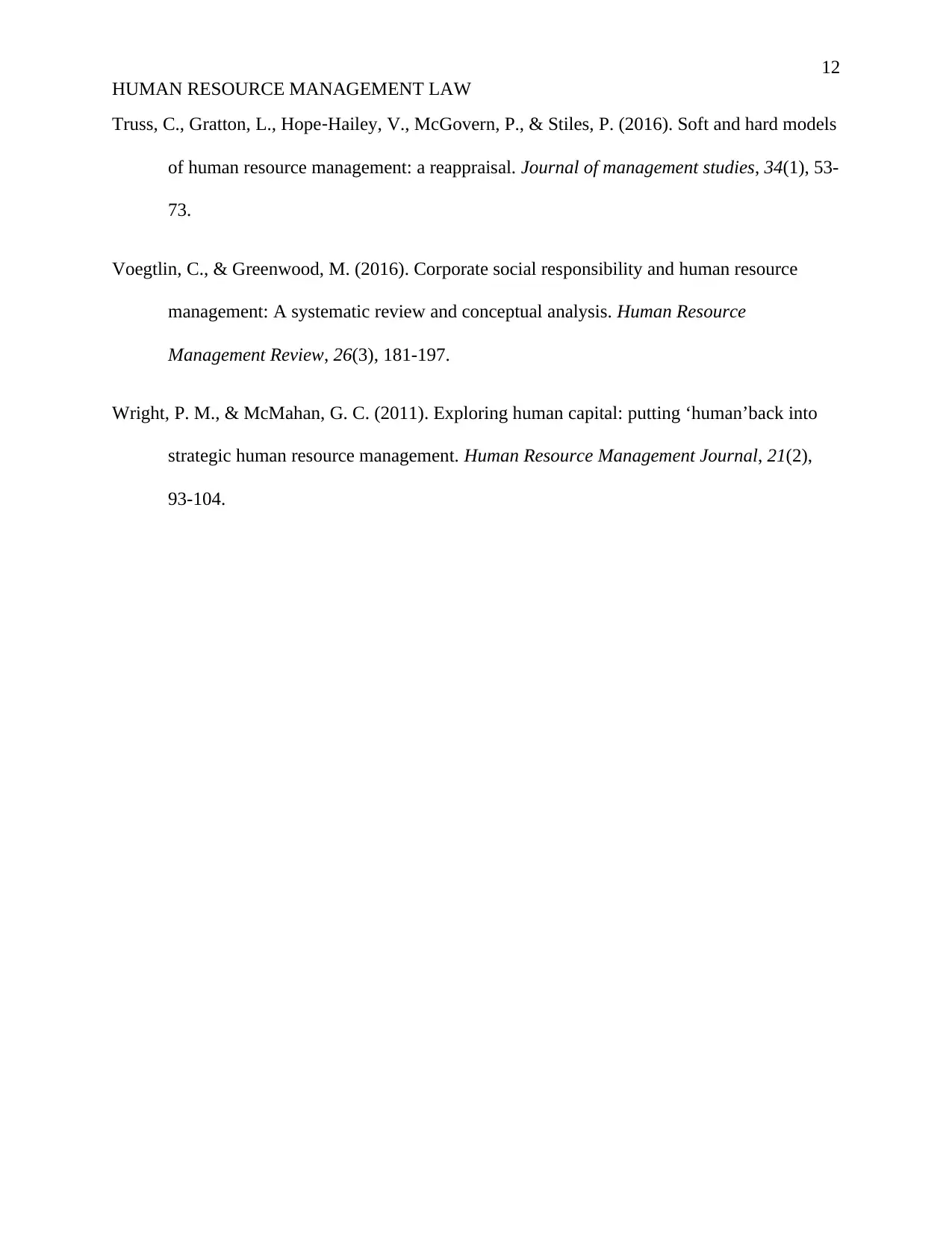
12
HUMAN RESOURCE MANAGEMENT LAW
Truss, C., Gratton, L., Hope‐Hailey, V., McGovern, P., & Stiles, P. (2016). Soft and hard models
of human resource management: a reappraisal. Journal of management studies, 34(1), 53-
73.
Voegtlin, C., & Greenwood, M. (2016). Corporate social responsibility and human resource
management: A systematic review and conceptual analysis. Human Resource
Management Review, 26(3), 181-197.
Wright, P. M., & McMahan, G. C. (2011). Exploring human capital: putting ‘human’back into
strategic human resource management. Human Resource Management Journal, 21(2),
93-104.
HUMAN RESOURCE MANAGEMENT LAW
Truss, C., Gratton, L., Hope‐Hailey, V., McGovern, P., & Stiles, P. (2016). Soft and hard models
of human resource management: a reappraisal. Journal of management studies, 34(1), 53-
73.
Voegtlin, C., & Greenwood, M. (2016). Corporate social responsibility and human resource
management: A systematic review and conceptual analysis. Human Resource
Management Review, 26(3), 181-197.
Wright, P. M., & McMahan, G. C. (2011). Exploring human capital: putting ‘human’back into
strategic human resource management. Human Resource Management Journal, 21(2),
93-104.
⊘ This is a preview!⊘
Do you want full access?
Subscribe today to unlock all pages.

Trusted by 1+ million students worldwide
1 out of 12
Related Documents
Your All-in-One AI-Powered Toolkit for Academic Success.
+13062052269
info@desklib.com
Available 24*7 on WhatsApp / Email
![[object Object]](/_next/static/media/star-bottom.7253800d.svg)
Unlock your academic potential
Copyright © 2020–2025 A2Z Services. All Rights Reserved. Developed and managed by ZUCOL.





